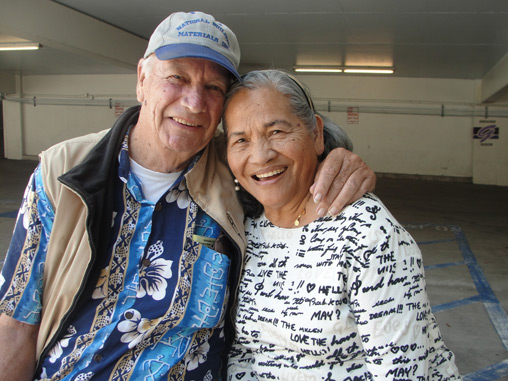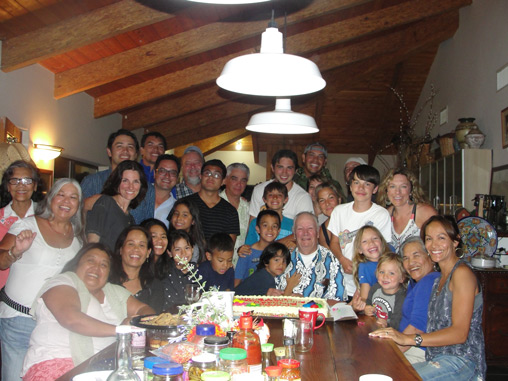
Anyone who knew Bill Coleman knew a person whose tireless curiosity led him to be well and broadly informed; whose love of the exotic introduced him to unusual people, places, plants, and animals; and who had a personality that could engage nearly anyone. These qualities defined Bill both socially and in the community, where he was best known as a farmer who was an important part of the original organic food movement and the development of the current farm-to-table and slow-food trends.
My elder brother had an early interest in animals, as most small children do, possibly sparked by our parents’ milk cow. By the time he was out of junior high, he had raised and tended goats, including a couple of milkers, and several batches of a hundred fryer chickens. He learned the lessons of animal care, including that its strict schedules interfered with his growing social life. By high school, he’d ditched the goats and chickens, keeping instead specimen birds, starting with beautiful pheasants — goldens and Amhersts — and peafowl, which roamed at large. With his agriculture teacher, he started collecting and propagating rare ornamental plants.
In his last year of high school, he was introduced to commercial agriculture by the Japanese tenants of some land his grandfather owned. Most of their produce was grown for local markets — standard fare such as tomatoes, corn, string beans, and berries. But they grew on a scale Bill had never seen, planting hundreds of feet of beans and five acres of tomatoes, farming with typical Japanese efficiency and with methods and practices not seen in an ag class.
Bill also spent several years working for a couple of older Filipino farmers. Like the Japanese, they were truck farmers, but they catered to Asian customers, retail grocers, and restaurants. Bill learned more methods and a different culture of gardening, with perhaps a greater reliance on certain things taking care of themselves. More important, Bill was involved in marketing produce, slowly extending the exotic goods to non-Asian customers. Bill was attracted to Filipino culture as a whole and gradually became an adopted member of the community, familiar with its farming and its cuisine and becoming conversant in at least three dialects.
A couple of years later, his father took a small, derelict lemon orchard in the foothills behind Carpinteria to settle a business debt. Bill moved in and was ready to farm, but he simultaneously had to hold a full-time job. He raised what he could — just a couple of crates of produce a week.
A major problem for very small-scale growers is finding a sales outlet. An ordinary grocery store can’t be bothered buying 15 pounds of string beans. Bill had luck with some small restaurants, selling small quantities of specialty items. But the many rewards of these interactions meant spending a lot of time for little income. The publication of Silent Spring began to change things.
Bill’s use of Japanese and Filipino traditions of only natural soil amendments or pest-control methods meant his produce was “natural” or “organic.” At the time, such produce had a mixed reputation. It might be safer to eat than supermarket fare, but it wasn’t appetizing: dirty, gnarled woody root crops, withered greens, and stunted, yellowing lettuce. By about 1970, enough people were aware of pesticides to create a significant demand for clean food. Organic produce began to be grown whose freshness, flavor, and beauty completely changed the image of naturally grown food.
The need for a trading venue brought into being the farmers’ market, a revival of an institution as old as civilization. Here, the buying public could interact directly with vendors and, not incidentally, with each other, exchanging not just cash and crops but news, ideas, and menu suggestions. The Santa Barbara Farmers Market started at the Mission grounds with Bill as a founding farmer.
Bill also ran an orchard crew full-time, which left him little time to garden. An acquaintance suggested that he select a couple of good orchard workers, show them what to do in the garden, and let them do the gardening while he ran the crew. This worked, and in the mid ’80s, Bill was able to fully support his family by farming together with his wife, Delia, and her flower business.
Farmers’ markets expanded through the ’90s, as did the market for organics. With Bill’s background, he knew the entire world had farmed organically before 1930. To his mind, if you couldn’t get good produce naturally, you needed to change your technique or product: Understand the plants and care for the soil, and they will cooperate with you. When the Department of Agriculture introduced a formal definition of “organic” and certification requirements, it was no longer practical for Bill and those who had established the concept to call their produce organic, though many, including Bill, were much stricter than the regulations. This reaffirmed Bill’s opinion of government, but it didn’t affect his business.
The farm began to supply the Santa Monica market, where flowers did very well, and the ethnic diversity of the clientele played right into Bill’s interests. Here were customers who would appreciate the oregano he’d gotten from a Lebanese immigrant: Oh, you have that oregano? Would you like to grow my Armenian one? Or: Do you know shambalileh? No? It’s the leaves of fenugreek. … Fenugreek leaves soon appeared among Coleman Farms’ herbs.
This was also when post-nouvelle restaurants arrived, featuring food that stood out for the quality of ingredients rather than artistic constructions on the plate. Bill and his son Romeo got to know chefs, who’d say: We’d like to make this, if only we could get that; could you grow it for us? Once, Romeo had half of his leeks planted denser than usual, thinking to thin them as they grew. But what do you do with several thousand junior leeks? A chef in L.A. soon offered a side of braised baby leeks. Exchanges like this helped develop the farm-to-table restaurant.
Selling produce outdoors in all weather is hard work. For fun, Bill and his staff usually tried to answer a customer in her or his native language. At one time, they could manage pretty well in about eight languages, from Arabic to Korean. Bill’s particular talent was assessing what a customer would respond well to, and he’d speak accordingly. He might end up having an outrageously funny conversation or a very prim one.
To relieve the responsibilities of running farm operations, Bill kept many kinds of birds. Their squawk or songs complemented the rustle of the breeze in the forest of bamboos around the aviary. As he grew older, he consulted them and thought-talked to them in their own language.
Anyone who worked for Bill never forgot it. His children learned a vast amount, some of it practical, like: “If you’re cold inside, go outdoors for a few minutes, and it will be warmer when you come back.” They learned to assess how much a customer wanted or needed to know and to supply that and nothing else, or maybe to supply that and the right joke. Many have careers that involve sales. They learned how to work with a diverse lot of people, some of whom could be difficult. But working with Bill was like English weather: You could never tell what might happen in 15 minutes, but it was usually mild, and even the worst thunderstorm was survivable.

